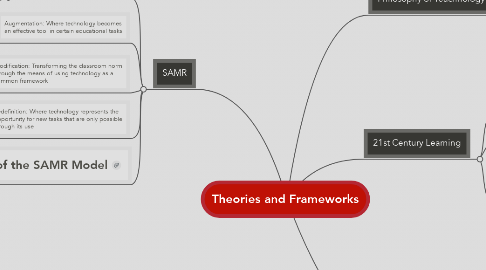
1. SAMR
1.1. Substitution: Where technology substitutes another educational task
1.1.1. For example: Students read a short story online instead of heading to the library to rent a copy
1.2. Augmentation: Where technology becomes an effective tool in certain educational tasks
1.2.1. For example: Having students submit an essay through e-mail therefore you are able to electronically submit to them the edited copy at a more rapid pace
1.3. Modification: Transforming the classroom norm through the means of using technology as a common framework
1.3.1. For example: Instead of handing an essay in on paper, students make an audio-recording of the essay.
1.4. Redefinition: Where technology represents the opportunity for new tasks that are only possible through its use
1.4.1. For example: Students make a video blog based off of their specified project, allowing for international connections and commentaries. This can be shown to other teachers, parents and their peers
1.5. Click here to see a chart of the SAMR Model
2. Philosophy of Teachnology
2.1. How you, as an educator, incorporate technology into your classroom.
2.1.1. Goal 1
2.1.2. Goal 2
2.2. Accessibility: How are your students going to do the activity? Do they have the proper equipment? Do you?
2.2.1. Session Rule 1
2.2.2. Session Rule 2
2.3. Assessment: How you will assess your students on a given technological activity. For example: when watching a video in class, give the students the learning objectives and have them write notes
2.4. Reinforcement: Technology should be reinforcing and complimenting the composed learning material presented to the class. It is considered another creative option to explore to widen students understanding of a given subject area.
2.5. Purpose: Each proposed activity should have a given purpose that fulfills specific learning objectives of the given subject material.
3. 21st Century Learning
3.1. Foundational knowledge that a student brings to the equation.
3.2. Produces information literacy.
3.3. 21st Century children are very technologically literate.
3.3.1. Although they may be able to access a source easily, how do they know that it is the correct source material?
3.3.2. We need to educate our students on the proper educational use of technology.
